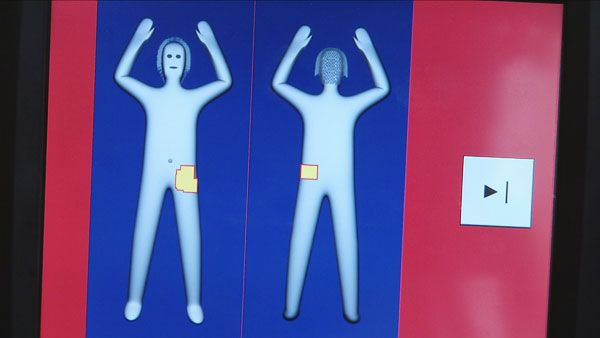Airport Body Scanner Radiation Barely A Thing To Worry About

Although there still may be issues with privacy when going through the full body scanners at airports, travelers need not worry about the radiation that these machines could possibly project onto them. A group of physics experts have found that they deliver less radiation than you would absorb if you were sitting in a park.
The report, commissioned by the American Association of Physicists in Medicine (AAPM) and performed by independent experts, examined two scanners at Los Angeles International Airport (LAX) and seven other scanners that were discontinued. They measured the radiation delivered, and found that for a man who was approximately 5' 10" and 161 lbs., one full body scan emitted about 11.1 nanosieverts of radiation. A Sievert is the common unit of radiation dose, and a nanosievert is one-billionth of a Sievert.
By comparison, the same person would absorb about 3.11 millisieverts of radiation each year — over 10,000 times as much as the body scan — and if the man was in a plane for 2.84 hours, he would absorb 9.4 microsieverts, which is still about 1,000 times more than the body scans.
In other words, they emit the same amount of radiation a person would absorb every 1.8 minutes if they were on the ground and every 12 seconds if they were in the air. They would also have to endure 22,500 scans in a year in order to reach the maximum dose of radiation. What's more, the two scanners they examined at LAX emitted even less radiation the discontinued ones - these seven were part of the older models, which largely became discontinued due to privacy concerns.
"This report represents a wholly independent review of the X-ray scatter airport scanners and is the first we know of to look at multiple scanners including those in actual airport use," Christopher Cagnon, the chief of radiology and physics at UCLA Medical Center co-author of the report, said in a press release. "We think the most important single take-away point for concerned passengers is to keep an appropriate perspective: the effective radiation dose received by a passenger during screening is comparable to what that same passenger will receive in 12 seconds during the flight itself or from two minutes of natural radiation exposure."
The reason radiation is higher when flying is because there is less atmosphere to shield passengers. However, radiation is everywhere; from terrestrial sources such as radon, cosmic radiation from space, and even the decay of potassium in the human body.



























